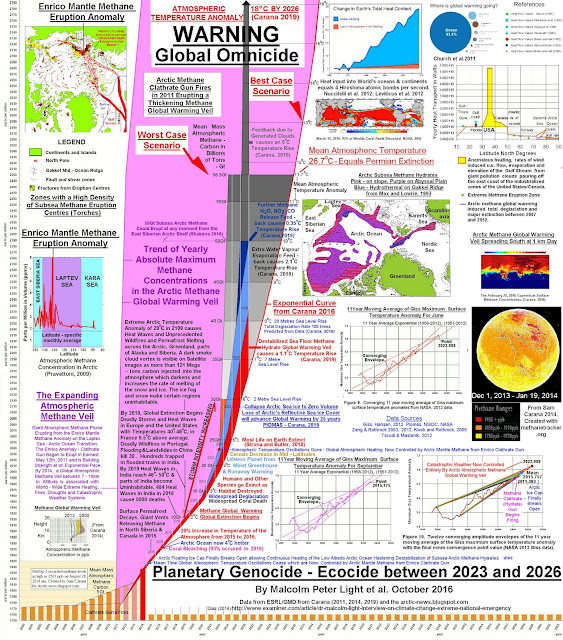The thick sea ice north of Greenland is breaking away due to high ocean heat and due to strong wind blowing from Greenland toward the North Pole, which is in turn due to deformation of the Jet Stream, one of the many feedbacks of the temperature rise.
 |
| [ click on images to enlarge ] |
On the right is a Naval Research Laboratory animation of Arctic sea ice thickness through July 29, 2024, with forecasts added through August 6, 2024.
The animation below shows a NASA Worldview animation of satellite images from July 25, 2024 to July 29, 2024. This is a 6.5 MB file, so if it doesn't show up due to its size, you may be able to view it by clicking on the Facebook comment box underneath.
 |
| [ click on images to enlarge ] |
The animation below shows the thickest Arctic sea ice breaking away from Greenland between July 24, 2024, and August 1, 2024.
Deformation of the Jet Stream
The Arctic Ocean is heating up as a result of increases in ocean heat and air temperatures. As sea ice melts away, feedbacks such as albedo changes further speed up the temperature rise. The Arctic Ocean is also heating up due to higher temperatures of river water. The temperature was as much as 14.8°C or 26.6°F higher than 1981-2011 at a location where water of the Ob River is flowing into the Arctic Ocean (green circle), as illustrated by the image below.
The Arctic Ocean is heating up as a result of increases in ocean heat and air temperatures. As sea ice melts away, feedbacks such as albedo changes further speed up the temperature rise. The Arctic Ocean is also heating up due to higher temperatures of river water. The temperature was as much as 14.8°C or 26.6°F higher than 1981-2011 at a location where water of the Ob River is flowing into the Arctic Ocean (green circle), as illustrated by the image below.
The image below shows the situation on August 2, 2024, when sea surface temperatures were as much as 15.8°C or 28.4°F higher than 1981-2011 where water of the Ob River is flowing into the Arctic Ocean (green circle). The image also shows wind at 250 hPa, illustrating deformation of the Jet Stream, with many circular wind patterns, another feedback of the temperature rise.
Permafrost decline results in more meltwater entering the Arctic Ocean from rivers. Deformation of the Jet Stream can strengthen heatwaves that heat up river water, causing a lot more heat to enter the Arctic Ocean. A deformed Jet Stream can also strengthen storms and rainfall, further speeding up the thawing of permafrost and resulting in more run-off of water into the Arctic Ocean. Furthermore, deformation of the Jet Stream can at times strengthen wind patterns that speed up the flow of rivers and ocean currents, speeding up disintegration of sea ice and resulting in more heat getting abruptly pushed into the Arctic Ocean.
The combination image below shows, on the left, a 16.7°C or 62.1°F sea surface temperature recorded on August 8, 2024, off the coast where the Mackenzie River flows into the Arctic Ocean (green circle); the Jet Stream shows many circular patterns and an omega pattern over the area with the green circle. On the right, the image shows a 34°C or 93.1°F surface temperature over land recorded on August 8, 2024, south of where the Mackenzie River enters the Arctic Ocean (green circle).
 |
| [ click on images to enlarge ] |
Deformation of the Jet Stream enables heatwaves to extend over the Arctic Ocean, with high air temperatures speeding up sea ice decline, while hot water from rivers further speeds up sea ice decline, resulting in loss of albedo, loss of the latent heat buffer and further changes that jointly speed up the temperature rise and further deform the Jet Stream.
The image below, from an earlier post, illustrates how multiple feedbacks and their interaction can accelerate the temperature rise.
In conclusion, deformation of the Jet Stream can contribute to higher temperatures by strengthening extreme weather events such as circular wind patterns, heatwaves, fires, storms, lightning and rainfall, i.e. by strengthening their intensity, frequency, duration and area covered, as also discussed and illustrated in earlier posts such as this one.
Further illustrating this is the image below, which shows numerous fires in Canada that cause emissions that in turn cause black carbon to be deposited on sea ice and permafrost, speeding up their decline and the temperature rise.
Further illustrating this is the image below, which shows numerous fires in Canada that cause emissions that in turn cause black carbon to be deposited on sea ice and permafrost, speeding up their decline and the temperature rise.
Climate Emergency Declaration
The situation is dire and the precautionary principle calls for rapid, comprehensive and effective action to reduce the damage and to improve the situation, as described in this 2022 post, where needed in combination with a Climate Emergency Declaration, as discussed at this group.
The situation is dire and the precautionary principle calls for rapid, comprehensive and effective action to reduce the damage and to improve the situation, as described in this 2022 post, where needed in combination with a Climate Emergency Declaration, as discussed at this group.
Links
• Nullschool
• NASA Worldview
https://worldview.earthdata.nasa.gov
• Both Paris Agreement thresholds clearly crossed
https://arctic-news.blogspot.com/2024/07/both-paris-agreement-thresholds-clearly-crossed.html
• Feedbacks
https://arctic-news.blogspot.com/2024/07/feedbacks.html
• Feedbacks in the Arctic
https://arctic-news.blogspot.com/p/feedbacks.html
• Jet Stream
https://arctic-news.blogspot.com/p/jet-stream.html
• Latent Heat
https://arctic-news.blogspot.com/p/latent-heat.html
• Albedo
https://arctic-news.blogspot.com/p/albedo.html
• Transforming Society
https://arctic-news.blogspot.com/2022/10/transforming-society.html
• Climate Plan
https://arctic-news.blogspot.com/p/climateplan.html
• Climate Emergency Declaration
https://arctic-news.blogspot.com/p/climate-emergency-declaration.html





























